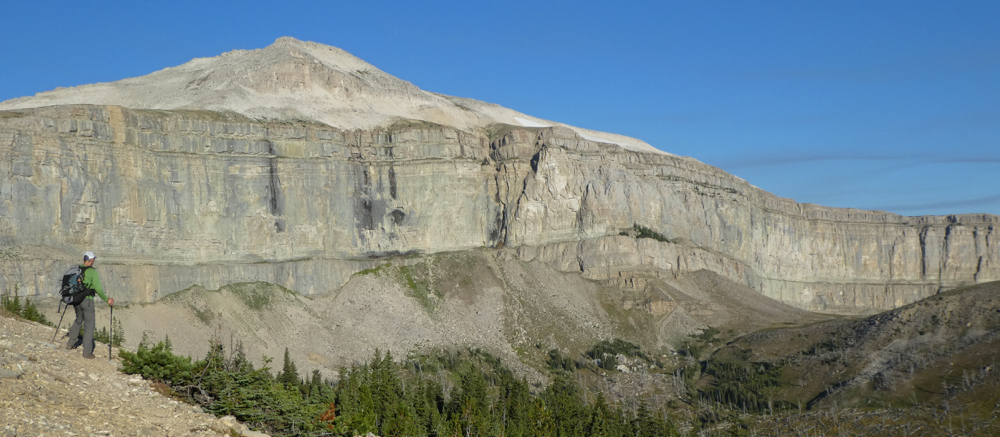|
Ancient Sea-Floor Sediment Stores Huge Amounts of Carbon. 
Scapegoat Mountain - CLICK HERE to view higher resolution photo.
Got carbonates?
Scapegoat Mountain (elevation 9,186) is located in the Scapegoat Wilderness 100 miles northwest of Montana. Both the cliff and peak are made of layers of carbonate rock deposited during the Cambrian Period (540-485 million years ago) when Montana was beneath a shallow part of the ocean as shown on this map. The cliff consists primarily of two limestone formations; the Pagoda formation lies beneath the Steamboat formation - and the peak is made of Devil's Glen dolomite. Limestone is mostly calcium carbonate (calcite, CaCO3), whereas dolomite is calcium magnesium carbonate. Dolomite can form as magnesium-rich groundwater moves through limestone, giving magnesium ions a chance to replace calcium ions.
Not that kind of reservoir.
Dolomites and limestones store huge amounts of carbon, hence they are an important reservoir (aka "sink") of carbon and part of Earth's carbon cycle. It is estimated that Earth's carbonate rocks store over 60,000,000 gigatons of carbon, compared to the estimated 840 gigatons in the atmosphere (Source: burnanenergyjournal.com). Atmospheric carbon is mostly in the form of CO2, and experts believe that CO2 levels during the Cambrian Period were much higher than today. Movement of this carbon from the atmosphere to the rocks shown in the photo began with rain. CO2 combined with water to form a weak carbonic acid that rained to the surface. This acidic rain "ate away" rock material (chemical weathering), releasing calcium, magnesium, and other ions that rivers carried to the ocean. In the ocean, the calcium ions combined with bicarbonate ions to form calcium carbonate, which precipitated to the sea-floor. These processes were certainly in high gear during the Cambrian Period as evidenced by the thickness of the carbonate layers shown in the photo. In fact the carbon in the cliffs of Scapegoat Mountain has been stuck there for 500 million years. So, what natural process(es) could put some of these carbon atoms back into the atmosphere? Read this to find out.
A couple "plot twists" in the carbon saga.
In modern oceans, most of the carbonate material being deposited originates from corals and shell-building organisms, including plankton (foraminifera, etc.). As these organisms die, they build up on the seafloor. Eventually layers of shells and sediment will be cemented together and become rock, storing the carbon in stone (limestone and dolomite). Another way that carbon is stored is as fossil fuels. Under certain circumstances dead plant matter or algae builds up faster than it can decay, Then as these deposits of organic carbon are buried and compressed they become oil, coal, or natural gas instead of sedimentary rock.
There's been a disturbance.
Scapegoat Mountain sits near the southern end of the Lewis Overthrust Belt, which includes the spectacular mountains that extend northward through Glacier Park, into Canada. The overthrusting happened as the Pacific Plate pushed into North America starting in the Middle Jurassic Period (174 to 163 mya) and ending in the Early Eocene Epoch (56-34 mya). The super-slow collision forced slabs of crust (mostly sedimentary rock) to fault, and then slip up and over younger layers to the east, resulting in the unique north-south trending ridges and valleys found along the Rocky Mountain Front.
The "Bob" is a great Montana place.
The Scapegoat Wilderness is part of the Bob Marshall Wilderness Complex south of Glacier Park - The fifth largest wilderness area in the lower 48 and home to some of the most primitive back-country in the USA. Affectionately known as "The Bob," the complex consists of three wilderness areas, including the original Bob Marshall, which was established in 1964, along with the Scapegoat and the Great Bear Wildernesses, which were added in the 1970s.
To learn more about Scapegoat Mountain and see many more photos, CLICK HERE.
Term: the "slow carbon cycle"
|


